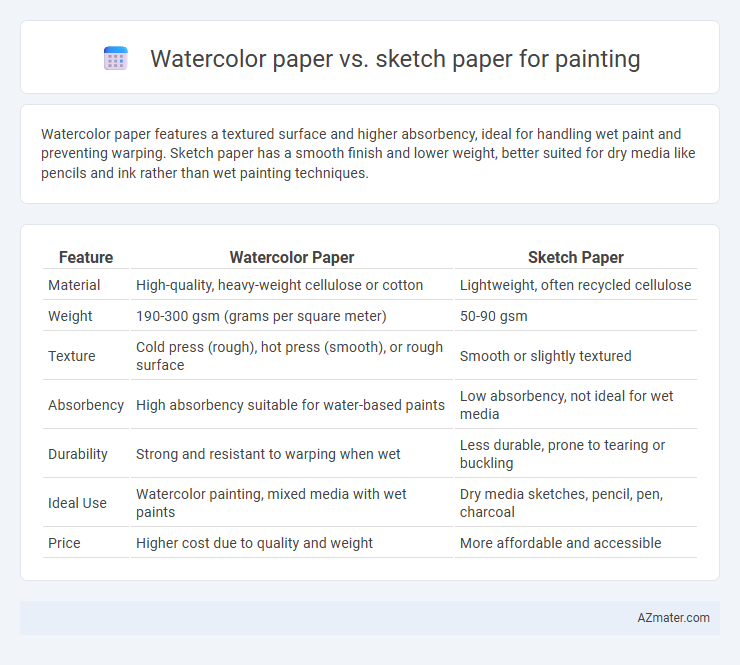Watercolor paper features a textured surface and higher absorbency, ideal for handling wet paint and preventing warping. Sketch paper has a smooth finish and lower weight, better suited for dry media like pencils and ink rather than wet painting techniques.
Table of Comparison
| Feature | Watercolor Paper | Sketch Paper |
|---|---|---|
| Material | High-quality, heavy-weight cellulose or cotton | Lightweight, often recycled cellulose |
| Weight | 190-300 gsm (grams per square meter) | 50-90 gsm |
| Texture | Cold press (rough), hot press (smooth), or rough surface | Smooth or slightly textured |
| Absorbency | High absorbency suitable for water-based paints | Low absorbency, not ideal for wet media |
| Durability | Strong and resistant to warping when wet | Less durable, prone to tearing or buckling |
| Ideal Use | Watercolor painting, mixed media with wet paints | Dry media sketches, pencil, pen, charcoal |
| Price | Higher cost due to quality and weight | More affordable and accessible |
Introduction to Watercolor and Sketch Paper
Watercolor paper features a textured surface specifically designed to absorb and hold water-based paints without warping or bleeding, making it ideal for watercolor techniques. Sketch paper is typically smoother and thinner, formulated for dry media such as pencils and charcoal, and lacks the absorbency required for wet paint applications. Choosing the correct paper depends on the painting medium, with watercolor paper providing durability and enhanced pigment control.
Understanding Paper Composition
Watercolor paper is specifically designed with a heavier weight, usually ranging from 140 lb (300 gsm) to 300 lb (640 gsm), and a textured surface that allows it to absorb water and pigment without warping or bleeding, thanks to its high cotton or cellulose content. Sketch paper, by contrast, is lighter, typically around 50 lb (75 gsm) to 80 lb (120 gsm), and features a smoother texture that suits dry media like pencil or charcoal but lacks the absorbency and durability needed for wet media. Understanding that watercolor paper's composition includes higher cotton content for durability and water retention, while sketch paper's composition is optimized for dry applications, helps artists choose the right substrate for their painting techniques and desired effects.
Texture and Surface Differences
Watercolor paper features a textured surface with varied finishes such as cold-pressed, hot-pressed, and rough, designed to hold water and pigments effectively without warping. Sketch paper typically has a smoother, lighter surface that is less absorbent, making it ideal for dry media like pencil or charcoal but unsuitable for heavy watercolor washes. The heavier weight and cotton content in watercolor paper provide durability and the ability to withstand repeated wetting and lifting techniques.
Weight and Thickness Comparison
Watercolor paper typically has a weight ranging from 190 gsm (grams per square meter) to 640 gsm, providing substantial thickness and durability ideal for water-based media, preventing warping and bleed-through. In contrast, sketch paper is much lighter, usually between 50 gsm to 120 gsm, resulting in a thinner, less absorbent surface better suited for dry media like pencil or charcoal but unsuitable for heavy washes. The higher gsm and thickness of watercolor paper enhance its ability to handle multiple layers of paint and water without deteriorating, whereas sketch paper's lower weight and thickness limit its use in wet applications.
Absorbency and How It Affects Painting
Watercolor paper features high absorbency due to its thicker, textured fibers, allowing it to hold and distribute water-based paints evenly without warping. Sketch paper has low absorbency, often causing watercolor pigments to pool or streak since the surface cannot retain moisture effectively. The absorbency difference directly impacts paint blending, color vibrancy, and texture retention during the painting process.
Durability and Longevity
Watercolor paper, designed with a heavier weight and higher cotton content, offers superior durability and longevity compared to sketch paper, which is thinner and less absorbent. Its robust texture prevents warping and withstands multiple layers of water and pigment without deterioration, making it ideal for long-lasting artworks. Sketch paper, while suitable for dry media, tends to yellow and degrade faster, lacking the archival quality necessary for preserving watercolor paintings over time.
Compatibility with Various Painting Techniques
Watercolor paper, made from high-quality cotton or cellulose fibers, offers excellent absorption and durability, making it ideal for wet techniques like washes, wet-on-wet, and glazing. Sketch paper, typically thinner and less textured, is better suited for dry media such as graphite, charcoal, and colored pencils but may buckle or tear under heavy washes. Artists seeking versatility often choose watercolor paper for mixed media projects that involve both wet and dry painting techniques due to its sturdiness and texture.
Cost and Accessibility
Watercolor paper typically costs more than sketch paper due to its thicker, textured material designed to absorb water without warping, making it ideal for watercolor painting. Sketch paper is more affordable and widely accessible, often sold in bulk, but it lacks the durability and absorption qualities needed for wet media. Artists seeking budget-friendly options for practice or dry media might prefer sketch paper, while those focused on watercolor techniques invest in specialized paper despite its higher price.
Choosing the Right Paper for Your Artwork
Watercolor paper features a thicker, more absorbent texture designed to handle washes and prevent warping, making it ideal for vibrant, fluid watercolor techniques. Sketch paper, typically thinner and smoother, suits dry media like pencils or charcoal but lacks the durability needed for heavy water or paint applications. Selecting the right paper enhances the artwork's longevity and appearance, with watercolor paper optimizing color blending and texture, while sketch paper supports detailed, crisp line work.
Final Thoughts: Which Paper Should You Use for Painting?
Watercolor paper offers superior absorbency and texture, making it ideal for wet media and detailed watercolor techniques. Sketch paper is thinner and smoother, better suited for dry media and quick studies but prone to warping when wet. For professional painting, especially with water-based paints, choosing watercolor paper ensures durability and vibrant results.

Infographic: Watercolor paper vs Sketch paper for Painting
 azmater.com
azmater.com